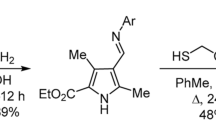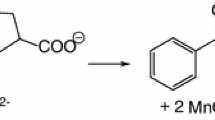Abstract
Purpose. The purposes were to study the kinetics of hydrolysis of 2′,3′,5′-triacetyl-6-azauridine ( 1 ) in aqueous solution (µ = 0.5) and to identify the main intermediates and products of the reaction.
Methods. A stability indicating isocratic LC assay was used to study the rate of degradation of 1 A gradient LC assay was used to study the time courses of the degradants. The products of hydrolysis were isolated by preparative liquid chromatography and identified by 1H-NMR and CI-MS. The pKa value was obtained by potentiometric titration.
Results. At 36.8°C, the pH-rate profile of 1 in water was adequately described by a four-term rate equation. The intermediates were identified as the primary and secondary di-acetates, and the primary and secondary mono-acetates. The final product was 6-azauridine.
Conclusions. A simplified kinetic scheme could be used to describe the concentration-time profiles of 1, the intermediates and the final product.
Similar content being viewed by others
REFERENCES
A. D. Welch, R. E. Handschumacher, and J.J. Jaffe. Studies on the pharmacology of 6-azauracil. J. Pharm. Exp. Ther. 129:262–269 (1960).
J. Koda, In A. C. Sartorelli and D. G. Johns, (Eds.), Handbook of Experimental Pharmacology, 38 Springer Verlag, Berlin 1975, pp. 348–372.
C. H. Doolittle, C. J. McDonald, and P. Calabresi. Pharmacological Studies of Neurotoxicity in Patients with Psoriasis Treated with Azaribine, Utilizing High Pressure Liquid Chromatography. J. Lab. Clin. Med. 90:773–785 (1977).
A. D. Welch, R. E. Handschumacher, S. E. Finch, and J. J. Jaffe. A Synopsis of Recent Investigations of 6-Azauridine (NSC-32074). Cancer Chemother. Rep. 39:39–46 (1960).
F. Sorm and J. Vesely. Potentiation of the Cancerostatic Effect of 6-Azauridine and 6-Azacytidine with 5-Bis-(2-chloroethyl)-aminomethyluracil. Experientia 17:355 (1961).
W. Drell and A. D. Welch. Azaribine homocystinemia-thrombosis in historical perspective. Pharmacol. Ther. 41:195 (1989).
M. Slavik, K. J. Smith, and O. Blanc. Decrease of Serum Pyridoxal Phosphate Levels and Homocystinemia after Administration of 6-Azauridine Triacetate and Their Prevention by Administration of Pyridoxime. Biochem. Pharmacol. 31:4089–4092 (1982).
R. E. Handschumacherm, P. Calabresi, A. D. Welsh, V. Bono, H. Fallon, and E. Frei. Summary of Current Information on 6-Azauridine. Cancer Chemother. Rep. 21:211–18 (1962).
A. Albert and E. P. Sergeant. The Determination of Ionization Constant. Chapman and Hall, London, 1–40 (1971).
R. M. Izatt, J. J. Christensen, and J. H. Rytting. Chem Rev. 71:439–481 (1971).
B. Anderson, M. Fung, S. Kumar, and D. Baker. Hydrolysis and Solvent Dependent 2′–5′ and 3′–5′ Acyl Migration in Prodrugs of 9-β-Arabinofuranylosyladenine. J. Pharm. Sci. 74:8 825–830 (1985).
Author information
Authors and Affiliations
Rights and permissions
About this article
Cite this article
Riley, C.M., Mummert, M.A., Zhou, J. et al. Hydrolysis of the Prodrug, 2′, 3′, 5′ -Triacetyl-6-azauridine. Pharm Res 12, 1361–1370 (1995). https://doi.org/10.1023/A:1016238110533
Issue Date:
DOI: https://doi.org/10.1023/A:1016238110533




